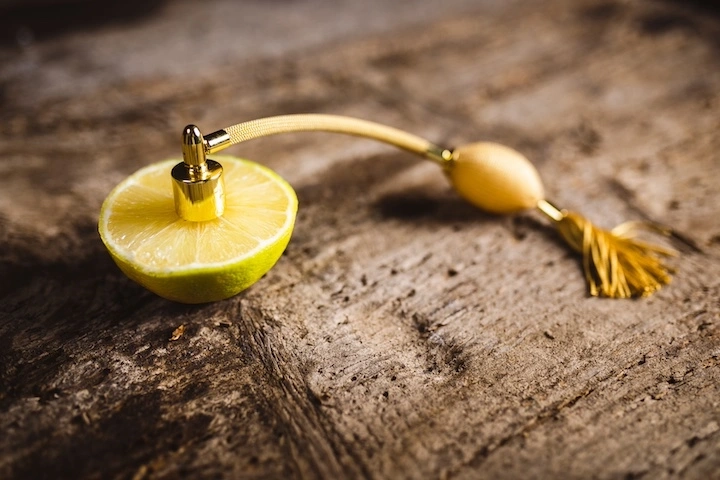
03 octobre 2024
Master the language of scents and tell your own story
The fragrance you wear narrates your story. But what if you could pen this tale yourself, using pure and natural ingredients? Welcome to the captivating realm of natural perfumery, where each fragrance is a unique creation, reflecting your personality and values.
Envision yourself, bent over your amateur perfumer's workbench, juggling vials of essential oils with intoxicating scents. On one side, the effervescent freshness of bergamot zest. On the other, the beguiling sensuality of Damask rose. In your hands lies the power to combine these essences, crafting an olfactory symphony that belongs solely to you.
This guide unveils the doors to this ancient art, revisited in light of our modern concerns for health and the environment. Gone are synthetic molecules and chemical fixatives! Make way for the potency of essential oils, these natural concentrates with myriad virtues.
Whether you're an entrepreneur seeking innovation or a curious amateur eager to explore new olfactory horizons, you'll find herein all the keys to embark on the adventure of natural perfume creation. Ready to compose your own olfactory signature, as unique as you are?
Key takeaways from this article
Here are the three main points to remember from this article on creating natural perfumes with essential oils:
- The structure of a natural perfume is based on the olfactory pyramid (top, heart, and base notes) and requires a meticulous selection of essential oils for each level.
- Formulating a natural perfume presents technical challenges, particularly in terms of stability, longevity, and reproducibility, which require specific expertise.
- Natural perfumes offer significant ethical and ecological advantages, in addition to their potential health and wellness benefits due to the properties of essential oils.
Approximate reading time for the full article: about 12-15 minutes.
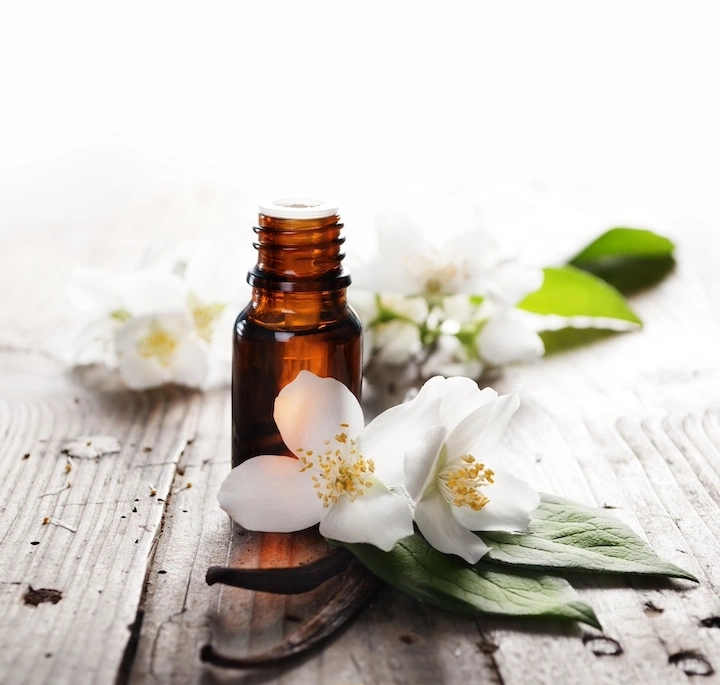
The foundations of natural perfumery
The central role of essential oils
Essential oils are at the heart of natural perfumery. These concentrated extracts from aromatic plants capture the very essence of their vegetable source. Obtained through steam distillation or cold pressing, they offer an incredibly rich and diverse olfactory palette.
Each essential oil possesses its own aromatic profile, influenced by numerous factors such as terroir, climate, or extraction method. It is this complexity that lends beauty and interest to natural perfumery.
Understanding the olfactory pyramid
The creation of a perfume revolves around the olfactory pyramid, composed of three levels:
- Top notes: These are the first perceived scents, generally fresh and light. They evaporate quickly (15-30 minutes).
- Heart notes: They constitute the body of the perfume and reveal themselves after the dissipation of the top notes. They persist for several hours.
- Base notes: These are the scents that linger longest on the skin, bringing depth and longevity to the perfume.
|
Top notes |
Heart notes |
Base notes |
|
angelica – bergamot – lemon – basil – coriander – cypress – tarragon - bay laurel – ledum – lemongrass – mastic - litsea cubeba – marjoram - red mandarin - green mandarin – melissa – spearmint – peppermint – myrtle – palmarosa – grapefruit – petitgrain – orange – sage – ravintsara - rosemary cineole - rosemary verbenone - tea tree - thyme thuyanol - thyme thymol - verbena |
dill - Roman chamomile - German chamomile - lemon eucalyptus - radiata eucalyptus - Bourbon geranium - rose geranium – jasmine - true lavender – lavandin – neroli – cinnamon – caraway – turmeric – ginger – nutmeg – pepper – savory – saro - ylang-ylang |
cade – cinnamon – cedar – cistus – oliban – spruce – juniper – clove – patchouli - Scots pine – sandalwood - silver fir - Douglas fir – vanilla - vetiver |
Choosing natural ingredients
The selection of ingredients is crucial in natural perfumery. Besides essential oils, one can use:
- Absolutes: highly concentrated extracts obtained through solvent extraction
- Natural resins and balsams
- Tinctures: macerations of raw materials in alcohol
- Vegetable oils as a dilution base
The quality and purity of these ingredients are essential for creating exceptional natural perfumes. You can find a wide selection of these natural extracts and essential oils on the Landema.com online store, specializing in the online sale of professional-quality plant extracts directly from the producer. Learn more about Why choose Landema
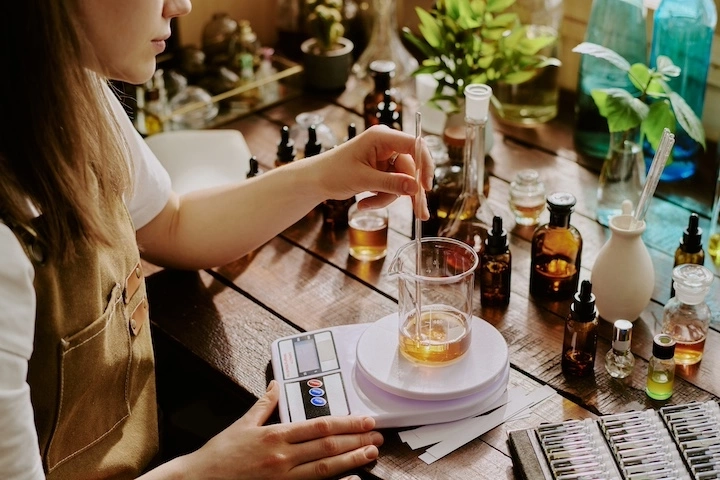
Necessary equipment and materials
To begin in natural perfumery, some basic tools are indispensable:
- Amber glass bottles to store blends
- Graduated pipettes and droppers for precise dosing
- A precision scale (accurate to 0.1g)
- Glass stirring rods
- Test strips
- A notebook to record your formulas
- Coffee filters for filtration
- A freezer for precipitating residues
For more professional equipment, you can invest in:
- A perfume organ kit to organize your ingredients
- A magnetic stirrer to homogenize blends
- A refractometer to measure the concentration of essential oils
Where to procure this material?
Suppliers specializing in aromatherapy generally offer all the necessities. To reduce costs, don't hesitate to turn to second-hand laboratory equipment or to make certain elements yourself, such as the perfume organ.
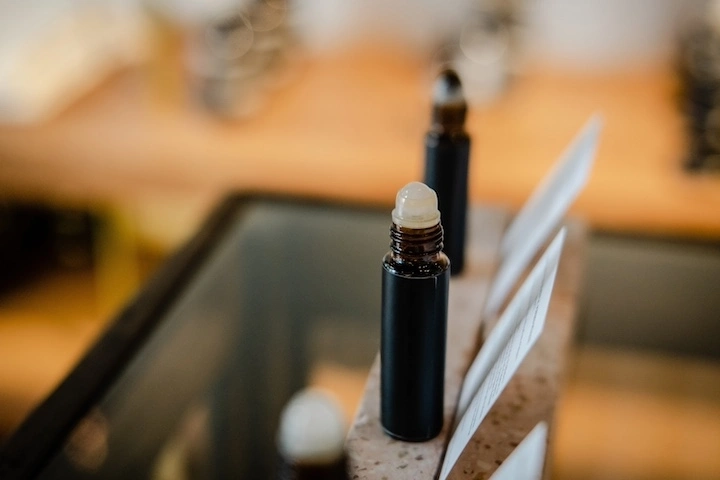
Advanced formulation techniques
Dilution and blending methods
Creating a natural perfume begins with diluting essential oils in a base. Common options are:
- Organic perfumery alcohol (96° ethanol)
- A neutral vegetable oil like Jojoba (Simmondsia chinensis)
- A mixture of alcohol and distilled water
The classic ratio is about 15-20% essential oils to 80-85% base. Start by mixing your essential oils together before gradually incorporating them into the base.
Where to buy perfume alcohol?
Alcohol is a key element in perfume creation. To obtain quality perfume alcohol, you have several options:
- Pharmacies: Some pharmacies sell 90° or 95° alcohol, perfect for perfumery.
- Specialized suppliers: Companies like Nadal Alcools offer organic alcohol specially designed for perfumery.
- Local distilleries: Some artisanal distilleries can provide neutral grain alcohol with high alcohol content.
- Online: Specialized natural perfumery sites sell perfume alcohol.
Always ensure you use food-grade alcohol, without additives or denaturants. 96° alcohol is ideal, but you can also use good quality vodka as an alternative.
Creating complex olfactory accords
An accord is a harmonious combination of several notes that creates a new scent. To compose complex accords:
- Start by defining the olfactory theme of your perfume
- Select a dominant note
- Add complementary notes to enrich the accord
- Balance the whole with binding notes
Don't hesitate to experiment and keep an olfactory journal to refine your technique over time.
To give you a guide on the proportions to consider for harmoniously arranging the different notes, you could start with 50% top notes, 30% heart notes, and 20% base notes.
Fixation techniques for better longevity
Longevity is a major challenge in natural perfumery. Here are some tips to improve the staying power of your creations:
- Use natural fixatives like Benzoin (Styrax tonkinensis), Tonka absolute (Dipteryx odorata), or Labdanum absolute (Cistus ladaniferus)
- Incorporate slow-evaporating essential oils, such as Sandalwood (Santalum austrocaledonicum) or Patchouli (Pogostemon cablin)
- Allow your perfume to macerate for several weeks before use
- Apply an oil base to the skin before the perfume
Purification and clarification techniques
To obtain a clear and stable perfume, several advanced techniques can be used:
- Freezing: Place your blend in the freezer for 24-48 hours. This will precipitate the natural waxes and residues present in your mixture.
- Filtration: After freezing, filter your perfume through a coffee filter. This will remove the solid particles that have formed.
- Decantation: Let your filtered perfume rest for several weeks. Any remaining impurities will settle at the bottom of the bottle.
- Siphoning: After the resting period, use a pipette to carefully extract the clarified perfume, leaving the sediments at the bottom.
These techniques allow for obtaining a clearer and more stable perfume while preserving its natural olfactory qualities.
Using absolutes
Absolutes are highly concentrated extracts that bring richness and depth to your creations. Here's how to use them effectively:
1. Solid or viscous absolutes:
- Gently warm the absolute in a water bath to liquefy it
- Use a heated spatula to extract the desired amount
- Dilute the absolute in a little warm alcohol before incorporating it into your blend
2. Dosage:
- Absolutes are very powerful, start with very small quantities (0.1-0.5% of the total formula)
- Adjust gradually, testing regularly
3. Integration:
- First mix the diluted absolute with your essential oils
- Then incorporate this mixture into your alcoholic or oil base
4. Maturation:
- Perfumes containing absolutes particularly benefit from an extended maturation period (4-8 weeks)
Judicious use of absolutes can bring an additional dimension to your creations, with deep and complex notes difficult to obtain otherwise.
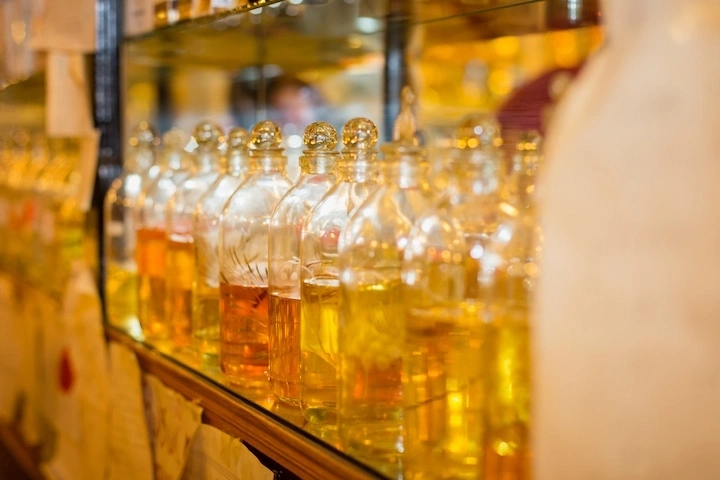
Innovative natural perfume recipes
Boreal Freshness
A fresh and invigorating perfume inspired by Nordic forests.
- 120 drops of Fir Balsam essential oil (Abies balsamea)
- 80 drops of Peppermint essential oil (Mentha x piperita)
- 60 drops of Cedarwood Atlas essential oil (Cedrus atlantica)
- 40 drops of Bergamot essential oil without bergaptene (Citrus bergamia)
- 20 drops of Juniper Berries essential oil (Juniperus communis)
Dilute in 50 ml of 96° organic alcohol. Let macerate for at least 3 weeks.
Oriental Dream
An enchanting fragrance with spicy and woody notes.
- 100 drops of Sandalwood essential oil (Santalum austrocaledonicum)
- 80 drops of Patchouli essential oil (Pogostemon cablin)
- 60 drops of Olibanum essential oil (Boswellia carterii)
- 40 drops of Vetiver essential oil (Chrysopogon zizanioides)
- 20 drops of Damask Rose essential oil (Rosa x damascena)
Dilute in a mixture of 40 ml organic alcohol and 10 ml jojoba oil. Let macerate for at least 3 weeks.
Floral Radiance
A delicate and refreshing floral bouquet.
- 100 drops of Geranium Bourbon essential oil (Pelargonium graveolens)
- 75 drops of Fine Lavender essential oil (Lavandula angustifolia)
- 50 drops of Ylang-ylang Extra essential oil (Cananga odorata)
- 40 drops of Neroli essential oil (Citrus aurantium amara)
- 25 drops of Petitgrain essential oil (Citrus aurantium amara)
- 10 drops of diluted Jasmine Grandiflorum absolute (Jasminum grandiflorum)
Mix in 50 ml of 96° organic alcohol. Let mature for 4-6 weeks for optimal results.
To personalize these recipes, don't hesitate to adjust the proportions or replace certain essential oils with others from the same olfactory family. Experimentation is key to finding your signature fragrance!
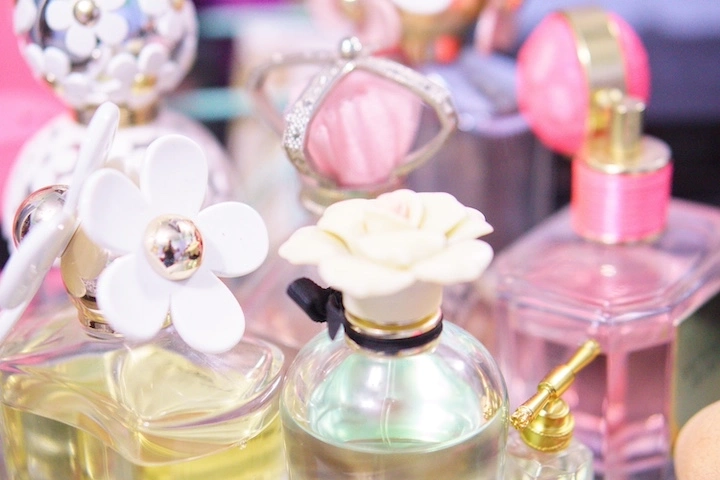
Challenges and solutions in natural perfumery
Natural perfumery presents some specific challenges:
- Stability: Natural ingredients can evolve over time.
Solution: use natural antioxidants like vitamin E.
- Intensity: Natural perfumes are often more subtle.
Solution: focus on the quality of ingredients and use powerful base notes.
- Allergens: Some essential oils can be allergenic.
Solution: always test your creations and respect recommended dosages.
- Sourcing: The availability of certain ingredients may vary.
Solution: diversify your sources and learn to work with alternatives.
- Clarity: Natural perfumes can be cloudy.
Solution: use the freezing, filtration, and decantation techniques described earlier.
- Reproducibility: Natural ingredients can vary from batch to batch.
Solution: keep a detailed journal of your formulations and adjust if necessary.
Commercial and legal aspects
If you're considering commercializing your creations, several points need to be considered:
- Regulation: In Europe, perfumes are subject to cosmetic regulation (EC) No 1223/2009. A product information file (PIF) is mandatory.
- Safety tests: Have your formulas evaluated by a certified toxicologist.
- Labeling: Mention all ingredients, potential allergens, and expiration date. European regulation 2023/1545 complements cosmetic regulation 1223/2009 and makes official the labeling obligation for 80 substances recognized as perfume allergens, effective from July 2026.
- Intellectual property: Protect your formulas and brand if necessary.
To start, consider selling at artisanal markets or online before launching into larger-scale production.
Trends and innovations in natural perfumery
The world of natural perfumery is constantly evolving. Here are some emerging trends:
- New extraction techniques: supercritical CO2 extraction allows for obtaining purer and more complex essences.
- Innovative ingredients: the use of novel raw materials such as algae or mushrooms opens up new olfactory possibilities.
- Solid perfumes: These alcohol-free formulations are gaining popularity for their practicality and sustainability.
- Adaptogenic perfumes: Inspired by aromatherapy, these perfumes aim to positively influence mood and well-being.
- Upcycling: Some brands are exploring the use of by-products from the food industry as new sources of fragrant ingredients.
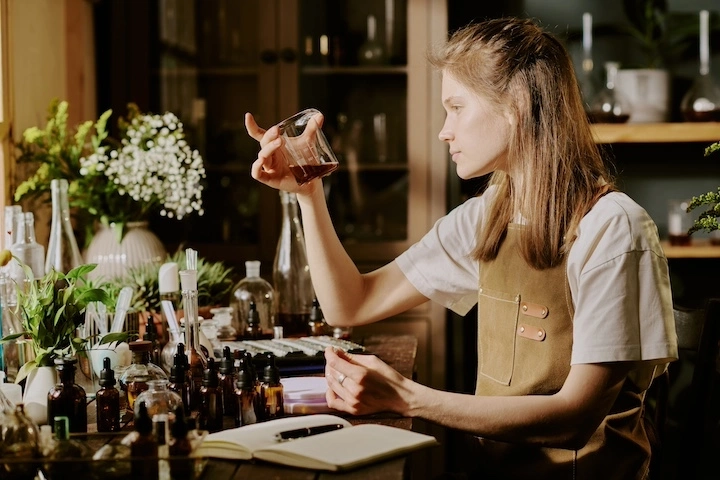
Towards ethical and ecological perfumery
Creating natural perfumes without chemicals is a fascinating art that combines creativity, science, and olfactory sensitivity. As an amateur perfumer, you have the opportunity to create unique, personal fragrances that respect the environment.
This guide has provided you with the basics to get started, advanced techniques to progress, and insights into the challenges and opportunities in the sector. Whether you wish to simply create for your personal pleasure or are considering launching your own brand, natural perfumery offers a vast field of exploration and learning.
Don't hesitate to experiment, refine your techniques, and develop your own olfactory style. Each trial, even unsuccessful ones, will bring you closer to creating your signature perfume.
May your journey into the intoxicating world of natural perfumery begin!
FAQ
Q: How long does a natural perfume last?
A: Generally between 6 months and 2 years, depending on the ingredients used and storage conditions.
Q: Can natural perfumes be created without alcohol?
A: Yes, by using vegetable oils or waxes as a base. Solid perfumes are a good example of this.
Q: Are natural perfumes less allergenic?
A: Not necessarily. Some essential oils can be very allergenic. It's important to always test and respect recommended dosages.
Q: How can I make my perfume more intense?
A: Slightly increase the concentration of essential oils and use powerful natural fixatives like Patchouli essential oil (Pogostemon cablin) or Vetiver (Chrysopogon zizanioides).
To go further
If you wish to deepen your knowledge and skills in natural perfumery, here are some avenues to explore:
Training and workshops
Participate in natural perfume creation workshops or take online courses taught by professional perfumers. These trainings will allow you to refine your technique and discover the secrets of master perfumers.
Advanced experimentation
- Tinctures and absolutes: Explore the use of tinctures and absolutes to enrich your creations. These concentrated extracts can bring depth and complexity to your perfumes.
- Olfactory accords: Learn to create complex olfactory accords by combining several essential oils to obtain a unique note.
- Solid perfumes: Try creating solid perfumes using natural waxes as a base. This form of perfume offers a different sensory experience and better portability.
Ethical and sustainable sourcing
Deepen your knowledge about the origin of essential oils and their environmental impact. Favor suppliers who practice sustainable and fair agriculture, such as the Biolandes Group, of which Landema is a part.
Aromachology
Study aromachology, the science that examines the influence of odors on the psyche and behavior. This knowledge will allow you to create perfumes that are not only pleasant but also beneficial for well-being.
Regulation and certification
If you're considering marketing your creations, familiarize yourself with the regulations in force in the cosmetic industry, particularly regarding allergens and safety tests. Also explore the various organic certifications available for natural perfumes.
Innovation and trends
Stay abreast of the latest innovations in natural perfumery, such as novel extraction techniques or the use of unprecedented ingredients. Monitor market trends to anticipate future consumer demands.
By exploring these various aspects, you will not only be able to refine your art of natural perfumery but also consider transforming your passion into a fulfilling and environmentally conscious professional endeavour.
Resources:
Items that could
interest
Our essential oils
will simplify your life
FAQ
As a customer of the Landema website, did you know that we also have a physical store? If you live in the Landes, in New Aquitaine or are planning to stay there, do not hesitate to visit us! We are located in Le Sen, on the Biolandes site, very close to Labrit, Roquefort, and Mont-de-Marsan, in the heart of the Landes de Gascogne regional natural park.
Essential oils are natural aromatic substances extracted from plants. They are often used in aromatherapy for their health and wellness benefits. Essential oils can be extracted from different parts of plants, such as leaves, flowers, barks, roots or seeds. The use of essential oils dates back to ancient times, where they were used for their medicinal properties and to perfume cosmetics and skincare products.
Landema invites you to discover our product range composed of essential oils, absolutes, vegetable oils, macerates or hydrosols. Our catalog will grow over time, stay informed by subscribing to our newsletter.
We invite you to discover our practical guides and our blog where you can discover our advice and our cases of use of essential oils.
Your wishlist
You must be logged in to post a comment.
Login, or create an account
There is no comment for this article yet